This article was co-authored by Pippa Elliott, MRCVS. Dr. Elliott, BVMS, MRCVS is a veterinarian with over 30 years of experience in veterinary surgery and companion animal practice. She graduated from the University of Glasgow in 1987 with a degree in veterinary medicine and surgery. She has worked at the same animal clinic in her hometown for over 20 years.
This article has been viewed 20,340 times.
Just like people, rabbits can feel uncomfortable on a hot day. In the best circumstances, rabbits will be kept in an environment at a temperature between 40 and 80 degrees Fahrenheit (approximately 4.5 - 26.5 C).[1] If temperatures rise above that, however, there are several techniques you can use to keep your rabbit cool and comfortable. You will also need to be on alert for any signs that your rabbit is suffering from the heat, and act quickly if it is.
Steps
Providing Comfort
-
1Bring your bunny indoors. If it is an especially warm day and you are concerned about your rabbit overheating outdoors, just let it hang out inside. Make sure that your house is cooler and bunny-proof first, however (all electrical cords should be covered or hidden, rooms your rabbit should not be in must be closed off, etc.).
- If your rabbit spends most of its time outdoors, be cautious when bringing it indoors. Sudden changes in environment might make it physically or emotionally stressed. Keep an eye on your bunny while it is indoors. If it seems stressed, take it back outdoors and look for other methods to keep it cool.[2]
- If your bathroom or another room has cool tiles on its floor, this can be a great place for your rabbit to play and beat the heat.
-
2Keep your rabbit out of direct sunlight. When it’s very hot outside, your rabbit will naturally want to seek some shade. If it is in a hutch that has bright sun beaming down on it, move the hutch to a covered area. If it is not possible to move the rabbit’s hutch, take the animal itself to a safe and cooler location.[3]
- If your rabbit or its hutch are indoors, closing curtains and/or blinds will also keep sunlight out and your rabbit cooler.[4]
- Keep in mind that you might have to periodically move the rabbit’s hutch during the day as the sun travels across the sky.
- Painting the hutch white will also keep it cooler, since this will radiate more light away.
Advertisement -
3Ensure good airflow. Making sure that air is circulating in and around your rabbit’s hutch will help keep it cool. If the hutch is outdoors, keep it away from any walls so that it is free on all sides. Indoors, you can place fans near the hutch. Don’t let the fans blow directly on the hutch, however, because many rabbits will not like this.[5]
-
4Put some cover over the hutch. Indoors or outdoors, you can provide some additional shade by placing a light sheet, umbrella, or similar covering on top of your rabbit’s hutch. If you are placing the cover directly on the cage, however, make sure that it is made of a breathable material—cloth works, but plastic or very thick covers might make the hutch too hot.[6]
-
5Drape the hutch with wet towels. If the covering on your rabbit’s cage is dampened, this can provide additional cooling power. You can also mist your rabbit’s hutch with water for a similar effect.
- If it is both hot and humid, however, this technique may actually make things worse. Only use damp dowels or misting to cool your rabbit when the humidity is relatively low.[7]
-
6Make the hutch flooring cool. When it gets hot, rabbits in the wild will naturally start to dig around in the ground to seek cooler spots below the surface. You can provide similar comfort to your rabbit by putting some cool ceramic tiles down in its hutch (or on the floor if it is indoors). You should be able to find some tiles at a hardware store. Spraying them with water and/or putting them in the refrigerator for awhile first will make them extra cool.[8]
-
7Put an icepack in your rabbit’s cage. Automatic cooling can be provided by a regular icepack or even a frozen water bottle. If you set one in your rabbit’s hutch, it can lean against it for a hit of relief. Make sure to wrap the icepack or bottle in a towel first, however, since direct contact with the frozen item might can be painful or cause frostbite.
- If your rabbit has a habit of chewing on water bottles or plastic, keep the bottle/icepack on top of or near the cage, but not in it.[9]
-
8Dampen your rabbit’s ears. Rather than perspiring, rabbits radiate heat from their ears to cool themselves. You can help this process by slightly misting your rabbit’s ears. Don’t overdo it, though—you want to dampen the ears, but not soak them. If it is humid outside, skip this step, since it can actually make your rabbit more uncomfortable.[10]
Feeding Your Rabbit
-
1Provide plenty of cool water. It’s always important to provide your rabbit with fresh water, but when the weather is very warm, it is critical. To encourage your rabbit to stay adequately hydrated during the heat, give it both a dripper and an open bowl of water. Replenish both frequently.[11]
-
2Give your rabbit frozen vegetables. When it’s hot, you might be tempted to get a cool treat to beat the heat. Your rabbit might just appreciate this, too. Try giving it frozen or chilled vegetables to nibble on and get some relief.[12]
- If you are adventurous, you can even try pureeing some vegetables and freezing them in ice cube trays. Once the cubes are ready, give one to your pet and see if it is interested in its very own rabbit “ice pop.”
-
3Offer your rabbit a treat. If you are concerned that your bunny is bothered by the heat, offer it one of its favorite treats. The comfort food might make it feel better. If the rabbit refuses treats, it could be a sign that it’s sick, or possibly seriously affected by the heat.[13]
Taking Precautions
-
1Handle your rabbit sparingly. Even if your rabbit is used to being moved around, this can cause it to feel stressed. When it’s already uncomfortable because of the heat, this stress can be more than the rabbit can take. If you must handle your rabbit during a period of hot weather, do so early in the morning or at night, since it will be cooler at these times.[14]
-
2Check the rabbit’s temperature. The normal body temperature for a rabbit ranges from 101 F - 103 F (38.3 C - 39.4 C). If you think that your rabbit might be too hot, take its temperature to be sure.[15]
- The best way to check your pet’s temperature is to use a plastic rectal thermometer. If you don’t have experience doing this, or are afraid of harming your rabbit, take it to a veterinarian for help.
-
3Learn the signs of heat prostration. When your rabbit is exposed to high temperatures for a prolonged period, they may begin to suffer heat prostration, which is a form of heat exhaustion. This is more likely to happen when temperatures are above 92 F (33 C). Symptoms of heat prostration in rabbits can include:[16]
- Bluish lips, tongue, or ears
- Increased pulse or breathing rate
- A wet nose or mouth
- Froth at the mouth
-
4Cool your rabbit quickly. If you see that your rabbit is showing signs of heat prostration, you will have to act quickly to save its life. Place the rabbit in a tub or basin of cool (not cold water) for a few seconds, making sure to keep its head out of the water. This will help bring your rabbit’s temperature back down. Call a vet or bring your rabbit to one for an examination as soon as possible.[17]
References
- ↑ http://msue.anr.msu.edu/uploads/234/43182/2014_files/4H1440_4-H_RabbitTracks_SummerRabbitCare.pdf
- ↑ http://articles.extension.org/pages/64501/hot-weather-care-for-rabbits
- ↑ http://msue.anr.msu.edu/uploads/234/43182/2014_files/4H1440_4-H_RabbitTracks_SummerRabbitCare.pdf
- ↑ http://articles.extension.org/pages/64501/hot-weather-care-for-rabbits
- ↑ http://www.therabbithouse.com/blog/2014/07/17/5-ways-keep-rabbit-cool-summer/
- ↑ http://msue.anr.msu.edu/uploads/234/43182/2014_files/4H1440_4-H_RabbitTracks_SummerRabbitCare.pdf
- ↑ http://msue.anr.msu.edu/uploads/234/43182/2014_files/4H1440_4-H_RabbitTracks_SummerRabbitCare.pdf
- ↑ http://www.therabbithouse.com/blog/2014/07/17/5-ways-keep-rabbit-cool-summer/
- ↑ http://www.therabbithouse.com/blog/2014/07/17/5-ways-keep-rabbit-cool-summer/
- ↑ http://www.therabbithouse.com/blog/2014/07/17/5-ways-keep-rabbit-cool-summer/
- ↑ http://articles.extension.org/pages/64501/hot-weather-care-for-rabbits
- ↑ http://www.therabbithouse.com/blog/2014/07/17/5-ways-keep-rabbit-cool-summer/
- ↑ http://www.bio.miami.edu/hare/sickbun.html
- ↑ http://articles.extension.org/pages/64501/hot-weather-care-for-rabbits
- ↑ http://msue.anr.msu.edu/uploads/234/43182/2014_files/4H1440_4-H_RabbitTracks_SummerRabbitCare.pdf
- ↑ http://msue.anr.msu.edu/uploads/234/43182/2014_files/4H1440_4-H_RabbitTracks_SummerRabbitCare.pdf
- ↑ http://msue.anr.msu.edu/uploads/234/43182/2014_files/4H1440_4-H_RabbitTracks_SummerRabbitCare.pdf
About This Article
To keep your rabbit cool on a sunny day, bring it indoors to protect it from the heat. If you'd rather leave it outside, try placing a light sheet or umbrella over the hutch to block out sunlight. Alternatively, wrap an ice pack in a towel and place it in the cage for your rabbit to lean on. Additionally, give your rabbit plenty of water to drink so it stays hydrated. You should also place it in a basin of cool water if you see signs of heat exhaustion, like rapid breathing or its its lips turning blue. For tips from our Veterinary co-author on how to feed your rabbit when it’s hot outside read on!

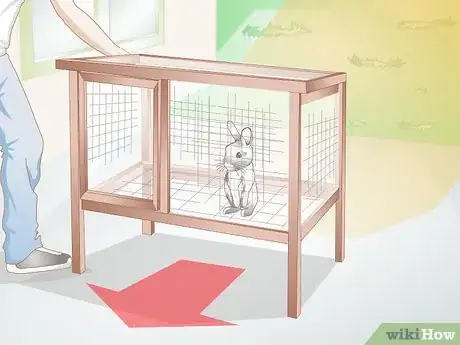

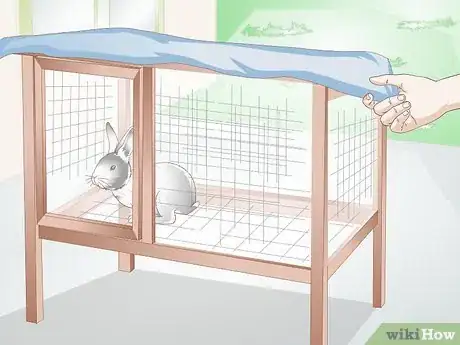
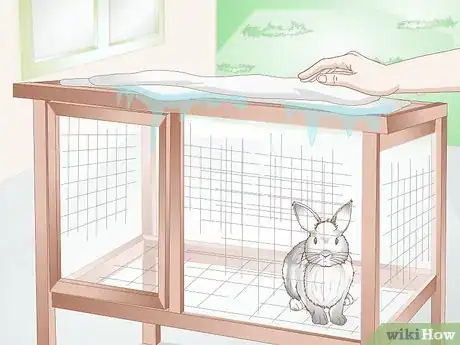

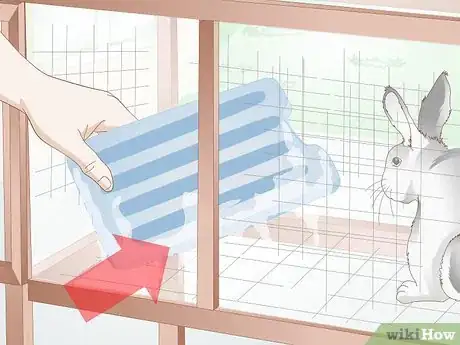

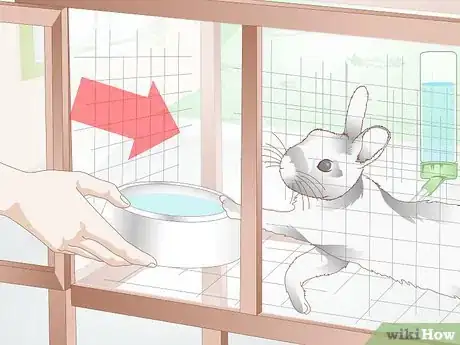




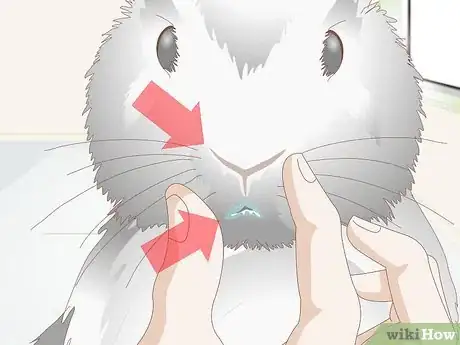
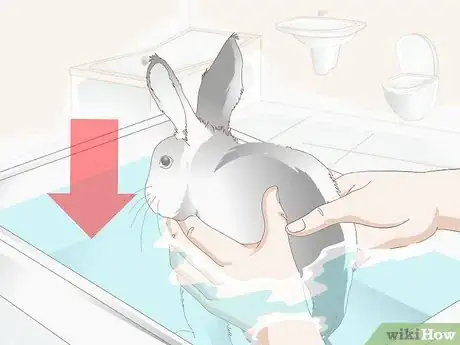



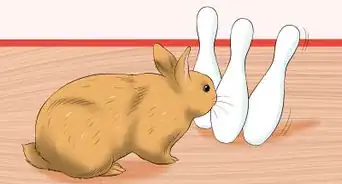



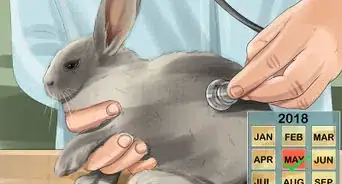

-in-Rabbits-Step-12.webp)















































